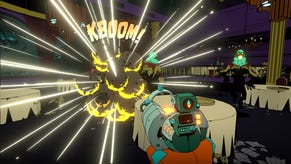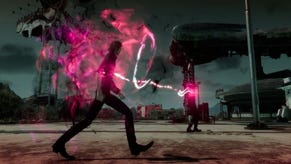Battalion 1944 is built on a different kind of historical research
Back to Brecourt
Battalion 1944 [official site] blindsided me. I played a few rounds last week at developer Bulkhead's studio in Derby and consistently came last in the leaderboards at the end of our team deathmatch battles. That's partly because I'm not the best FPS player in the North West, let alone the world, and it's partly because I was playing with the people who made the game. They know the maps, they know the weapons, they know the details of motion and gunplay. There's a much more simple reason though: I was crouching and crawling and looking for the perfect shot instead of running and jumping and shooting anything that moved on sight.
The level I played, the Manor house, contains elements of the historic assault on Brecourt Manor, which you may remember from episode two of Band of Brothers. Visually, the cues are striking, but this is a traditional deathmatch game, with rapid respawns and movement rather than an attempt to recreate anything resembling reality. Battalion blindsided me because it is, aesthetically, very successful in conjuring up one kind of history but the way it plays is looking to much more recent historical references.
Producer Joe Brammer, after virtually killing me what felt like a hundred times or more, explained that the most important historical research the team had conducted had been into their favourite multiplayer FPS games rather than into the setting. An age difference of a decade meant that our reference points where somewhat different – classic FPS to Joe means Call of Duty 2, CounterStrike and Medal of Honor rather than Doom and Quake – but we shared an understanding of what makes a good shooter tick. Except when I say we shared an understanding, what I really mean is that Brammer and his team have done the hard work of studying code to understand the complexities that go into an FPS game's feel while I've just played a whole lot of them.
It's a vague term, “feel”. I know what I mean when I say a game feels just right, but I'd find it very difficult to break down exactly why it feels right, or what could be done to improve it. Brammer can talk the science of feel, explaining how his team have effectively reverse-engineered the code from some of their favourite games to figure out exactly why it is that a gun should sit in a specific position on the screen, or have just the right animation linked to its transition into ironsights. He explains that the Unreal Engine provides unwanted fixes for some of their features, breaking their strafe-jumping for example. They had to reintroduce it as a 'bug'.
The presence of strafe-jumping does a good job of explaining my confusion. I don't remember soldiers in WWII being so agile. In one of the rare quiet moments during our play session, I watched a teammate hop onto a wall, scurry along it toward the manor house, and then leap through the window. I hadn't even realised I could get onto the wall in the first place.
It turns out there are many ways to enter the building, including at least three windows on the second floor. A little bit of imaginative navigation around the level reveals all kinds of pathways, many of them requiring players to use the vertical as well as the horizontal. There I was, dying over and over again as people ambushed me while I attempted to make my way up the stairs, and everybody else was jumping in and out of the windows.
Battalion is a game in which death comes quickly, from a hail of bullets from an SMG or a single, perfectly aimed shot from a rifle. It does away with classes, allowing players to choose a weapon at the start of a round but giving them the freedom to pick up any of the guns dropped by fallen opponents or allies. In the team deathmatch mode, communication is important, but as long as you keep moving and take your shots well, it's possible to contribute even if no plans are in place. The speed with which battle is joined, a symptom of the tight but dense maps, means that across a five minute round kills and deaths can easily be well into the double figures. I did manage to pick people off from a distance a few times but spending more than a few seconds in one place was usually fatal. Movement is key.
Thankfully, that elusive element, the 'feel' of the game, is tremendous. Given how the brief span of a single life could make death inconsequential until the scores are totted up at the end of a round, it's pleasing to feel a tension whenever a firefight breaks out. The sound design contributes a great deal – the crackle of combat leads you toward danger and a single shot can send you scrambling for cover. They key, as I learned, is to move on from that cover rather than cowering there, because whoever fired that shot is almost certainly hunting you rather than trying to pin you down. There's pressure from all sides, so nobody can afford to leave themselves open to an attack from the flanks or behind for long.
Level design will be key to finding ways to make the frantic combat work well. The Manor House is like a block of Swiss cheese, with its multiple entry points at various levels, and the area around it has trenches to move through quietly (or become cornered in) as well as elevated routes. Other maps need to offer similarly treacherous layouts, keeping players on their toes, while introducing a variety of settings and features.
Bulkhead's exhaustive research approach to getting 'feel' right is already paying off though. Even in the brief time I played, my old-school FPS muscle memory was slowly coming back to life and that made me want to stick around and actually improve. It's not the only multiplayer shooter trying to move away from unlocks and class systems for purely skill-based competition, but the studio's love of the genre combined with a thorough approach to constructing their systems is already evident.
There's talk of a simple card-based system running through multiple rounds of competition, allowing teams to decide when they should deploy specific firearms and auxiliary weapons such as frag and smoke grenades. That sounds good to me, introducing an element of tactical bluffing and risk, and I'm interested to see the Domination style mode will work as well. Hopefully it'll change the pace, having one team defend and the other attack rather than everyone rushing around with no objective other than to kill as quickly and frequently as possible.
For now though, the focus is on making sure the combat and the design of the maps works to create a strong and intense FPS, and on the evidence of what I've seen, it all feels spot on, even if it is far faster and more frantic than expected.
















